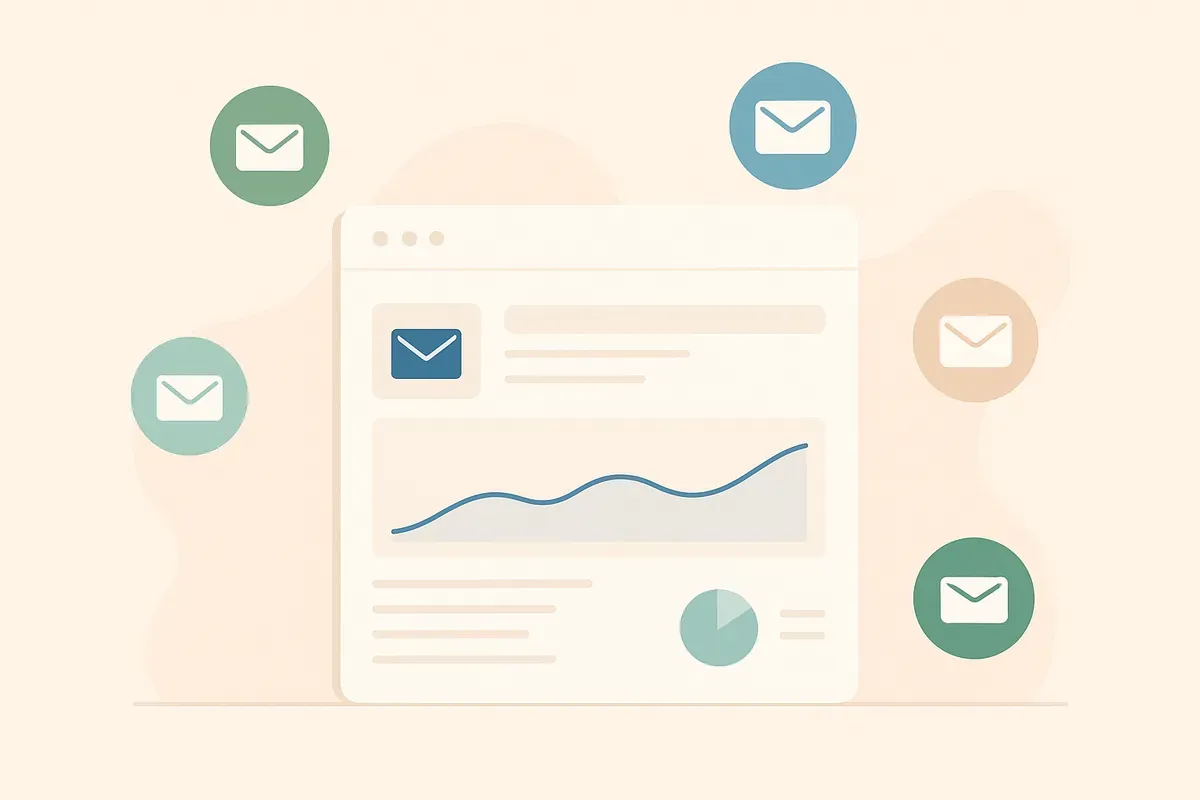7 Best Mailchimp Alternatives in 2026 (Free & Paid)
Compare 7 Mailchimp alternatives for 2026 — simpler, more affordable tools with flat pricing, SMTP options and a practical migration checklist.

Last updated: 29 August 2025
Email marketing shouldn’t feel like paying a tax for features you don’t use. If Mailchimp’s pricing or complexity isn’t a fit anymore, there are excellent alternatives that offer simpler workflows, clearer costs, and (if you want it) full control over delivery via SMTP.
This guide compares seven credible options, explains who each one suits best, and gives you a practical migration checklist. We’ve kept claims modest, linked to official sources for pricing/features, and avoided unverified “deliverability percentages”.

Quick comparison (at a glance)
| Platform | Pricing model (high-level) | SMTP support | Typical contact limits | Best for |
|---|---|---|---|---|
| Groupmail | Flat tiers (Free / Individual / Business) | ✅ Bring-your-own SMTP (e.g. SMTP2GO, SendGrid) | 1k / 10k / 50k tiers | Small teams, predictable costs, SMTP control |
| Constant Contact | Contact-based monthly pricing; send allowance tied to tier | ❌ Uses own infra (no BYO SMTP) | Scales by contact tiers | Local businesses, events, straightforward automations |
| Brevo | Volume-based (emails/month); Free plan has daily cap | ✅ Transactional API/SMTP available | Contacts broadly uncapped; sending caps on Free | E-commerce, multi-channel (email, SMS, WhatsApp) |
| Moosend | 30-day free trial; paid plans thereafter | ✅ SMTP/Transactional on paid | Scales by contacts | Budget-friendly campaigns + transactional |
| MailerLite | Free plan (1,000 subs / monthly cap) + paid tiers | ❌ No BYO SMTP (uses own infra) | Scales by subscribers | Creators & small teams; clean editor |
| GetResponse | Contact-based tiers; transactional via MAX add-on | ✅ Transactional via API/SMTP (MAX add-on) | Scales by contacts | All-in-one marketing, webinars, funnels |
| Campaign Monitor | Contact-based tiers | ✅ Transactional via API/SMTP gateway (no BYO) | Scales by contacts | Design-focused teams & agencies |
Note: Pricing and features change often. Always check the official pricing pages linked above for current details.
Feature deep-dive (table)
| Platform | Editor & templates | Automation scope | Analytics | Integrations | Deliverability controls | Learning curve |
|---|---|---|---|---|---|---|
| Groupmail | Drag-and-drop, mobile-optimised | Lean (bounce/unsubscribe handling; no complex flows) | Real-time campaign reporting | SMTP2GO, SendGrid, + core marketing stack | BYO SMTP, domain auth (SPF/DKIM/DMARC) | Very low |
| Constant Contact | Easy editor, many small-biz templates | Welcome series, date & behaviour triggers | Standard campaign metrics | Shopify, WordPress, CRM/accounting tools | Built-in sending with auth guidance | Low |
| Brevo | Modern editor; multi-channel campaigns | Advanced workflows + SMS/WhatsApp steps | Robust; per-channel breakdowns | Large app ecosystem; e-commerce friendly | Transactional API/SMTP; auth & warmup tools | Medium |
| Moosend | Clean builder; decent template set | Good for SMB needs | Standard metrics, segmentation | Popular CMS/e-comm tools | SMTP on paid; domain auth | Low-medium |
| MailerLite | Very tidy builder; fast to ship | Visual flows; good enough for most | Clean reporting; click maps | WordPress, Shopify, Zapier, etc. | Built-in sending; auth guidance | Low |
| GetResponse | Builder + landing pages + funnels | Advanced; webinar & e-comm triggers | Comprehensive suite-level analytics | Large ecosystem; ads & CRM options | Transactional via API/SMTP add-on | Medium |
| Campaign Monitor | Polished editor; agency workflows | Solid basics; less “marketing cloud” | Client-friendly reporting | Good design/agency integrations | Transactional API/SMTP gateway | Low-medium |
1) Groupmail

Groupmail focuses on the essentials: build good-looking emails, send reliably, and keep costs predictable. It’s especially handy if you want control over delivery by connecting your own sending service—like SMTP2GO or SendGrid.
Stand-out strengths
- Flat pricing tiers with generous contact limits and unlimited sends on paid plans.
- Bring-your-own SMTP for control over IPs, routing and reputation.
- Fast setup: intuitive editor, templates, and real-time analytics.
Things to consider
- Lean automation: perfect for newsletters and campaigns; not aimed at complex, multi-branch journeys.
Best for: small teams that value simplicity, control, and predictable costs.
2) Constant Contact

Constant Contact is popular with local businesses and organisations that want a friendly editor, event tools and phone support.
Stand-out strengths
- Approachable tooling with lots of ready-made templates.
- Contact-based pricing that’s easy to reason about for smaller lists.
- Support options include phone—rare at this price point.
Things to consider
- No BYO SMTP; you’ll use their infrastructure and allowances tied to your tier.
Best for: local businesses, clubs, events and community organisations.
3) Brevo (formerly Sendinblue)

Brevo brings email, SMS and WhatsApp under one roof. The free plan allows 300 emails/day; paid plans unlock higher monthly volume. Transactional email is available via API/SMTP.
Stand-out strengths
- Multi-channel automation (email + SMS + WhatsApp) in one place.
- Generous contact handling (especially compared to strict contact caps elsewhere).
- Transactional API/SMTP for order receipts, password emails, etc.
Things to consider
- More moving parts: worthwhile if you’ll actually use multi-channel flows.
Best for: e-commerce and teams ready to use multi-channel journeys.
4) Moosend

Moosend is a budget-friendly platform with a 30-day free trial and paid plans that include SMTP/transactional sending.
Stand-out strengths
- Low entry cost with enough power for most SMB campaigns.
- SMTP on paid plans for transactional or app-driven email.
Things to consider
- Interface and integrations are solid, though not as broad as “marketing cloud” suites.
Best for: small teams that want campaigns + transactional on a budget.
5) MailerLite

MailerLite is a crowd-pleaser for creators and lean teams. Clean editor, sensible automations, and a generous free plan.
Stand-out strengths
- Very tidy editor and simple workflows—great for shipping fast.
- Free plan (1,000 subs; monthly email cap) to get moving.
Things to consider
- No BYO SMTP; you’ll send through MailerLite’s infrastructure.
Best for: bloggers, makers, and teams that value speed and clarity.
6) GetResponse

GetResponse bundles email with landing pages, funnels and webinars. Transactional email is available as a MAX add-on and can be sent via API/SMTP.
Stand-out strengths
- All-in-one toolkit if you want to consolidate vendors.
- Advanced automations and webinars/funnels for education-led marketing.
Things to consider
- Broader suite means more configuration; good fit if you’ll use the extras.
Best for: teams that want one platform for campaigns, funnels and events.
7) Campaign Monitor

Campaign Monitor is beloved by design-conscious teams and agencies. For transactional, it provides a dedicated API/SMTP gateway (you don’t bring your own SMTP).
Stand-out strengths
- Polished templates and client-friendly reporting.
- Agency workflows that keep stakeholders happy.
Things to consider
- Focused on great campaigns and client delivery rather than deep multi-channel extras.
Best for: teams where design polish and approvals matter most.
Who should choose what?
- Predictable costs + SMTP control: Groupmail
- Phone support + straightforward tools: Constant Contact
- Multi-channel + transactional: Brevo
- Low-cost + SMTP transactional: Moosend
- Tidy editor + generous free tier: MailerLite
- All-in-one (funnels/webinars) + optional transactional: GetResponse
- Design polish + agency workflows: Campaign Monitor
Pricing notes & simple cost scenarios
Important: exact prices and thresholds change, and many tools offer yearly discounts. Always confirm on the vendor pricing pages. The goal here is to help you think about how pricing scales, not to freeze numbers.
- Contact-based pricing (e.g., Constant Contact, GetResponse, Campaign Monitor, MailerLite): predictable if your list is steady, but costs rise as contacts grow.
- Volume-based pricing (e.g., Brevo): good when you have lots of contacts but send less frequently.
- Flat tiers (Groupmail): predictable if you send often and don’t want to juggle overage math.
- Transactional add-ons (e.g., GetResponse MAX, Brevo, Moosend): useful for receipts, password resets, etc., often billed separately.
Scenarios (illustrative only):
- Newsletter-heavy startup (10,000 contacts; 4 sends/month): Flat-tier or contact-based both work; if you hate overage anxiety, flat tiers are calming.
- E-commerce brand (80,000 contacts; mixed promos + order emails): Consider Brevo for multi-channel + transactional or GetResponse for suite features; weigh list growth vs send volume.
- Design-led agency (multiple client brands): Campaign Monitor’s polish and client-friendly reporting can save time in approvals.
Switching from Mailchimp: step-by-step
- Audit your account: lists/audiences, tags, segments, signup sources, and any key automations you actually use.
- Export clean data: contacts (with consent status), tags/segments, and template HTML where needed.
- Pick your delivery model: built-in sending vs bring-your-own SMTP (e.g., SMTP2GO or SendGrid).
- Authenticate your domain: set SPF, DKIM and (ideally) DMARC before the first big send.
- Rebuild essentials: your newsletter template, key segments, and any must-have automations.
- Warm up gently: start with engaged segments; ramp volume; watch bounces/complaints.
- Monitor and tweak: track opens/clicks, mailbox-provider errors, and list hygiene (prune hard bounces and spam traps).
Methodology
We focussed on clear pricing models, SMTP/transactional options, and fit by use case. We linked to official pricing/features pages for verification, avoided vendor-specific deliverability claims, and kept recommendations practical rather than hype-driven.
FAQs
Is there a genuinely simple, low-cost alternative to Mailchimp?
Yes—Groupmail offers flat pricing with unlimited sends on paid plans and full SMTP integration, which keeps costs predictable as you grow. See the latest pricing.
What’s the difference between “BYO SMTP” and built-in sending?
BYO SMTP means you connect a provider like SMTP2GO or SendGrid to handle delivery, giving you more control over reputation, IPs and routing. Platforms without BYO SMTP send via their own infrastructure—simpler to set up, but less flexible if you have specific delivery requirements.
Which tools include transactional email?
Brevo (API/SMTP), Moosend (paid plans), GetResponse (MAX add-on via API/SMTP), and Campaign Monitor (API/SMTP gateway) all support transactional sending. Check the linked docs for plan requirements.




